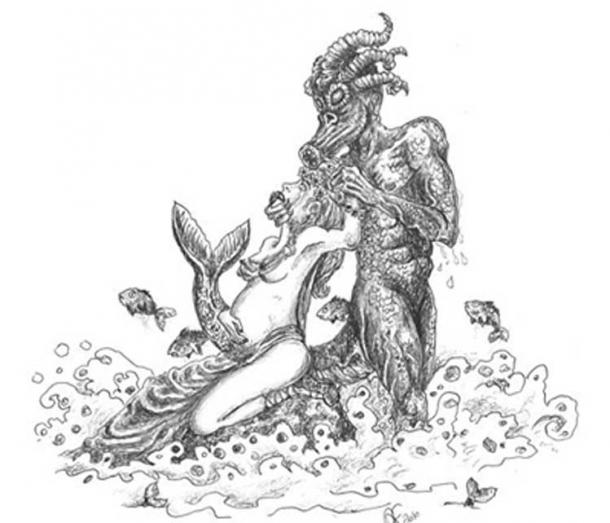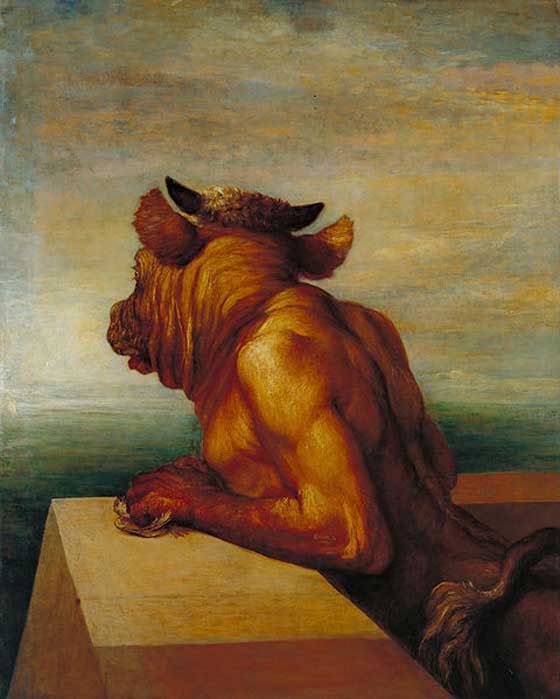Were the Merovingians Descended from a Monster? Meet the Quinotaur
You’ve probably heard of a Minotaur (half-man, half-bull), but what about a Quinotaur? In early Frankish history there was a “beast of Neptune” which was said to look like a creature called a Quinotaur. This mysterious mythical being only appeared in one text, but he was said to have fathered a line of kings whose descendants still survive today, and they even made an appearance in The Da Vinci Code.
Merovech, Founder of the Merovingians
This story involved the Franks, a Germanic tribe whose descendants eventually migrated to and ruled parts of what is now modern France, Germany, and Belgium. In a history of the Frankish people, the cleric Fredegar attributed the founding of its ruling dynasty, the Merovingians, to one guy named Merovech. Gregory of Tours was the first source to mention Merovech. But he doesn’t give Merovech a monstrous lineage, instead making him a mortal man who founded a new royal dynasty.

Merovech, founder of the Merovingians. (Public Domain)
A Descendant of Chlodio?
Gregory stressed the accomplishments of his descendants, including his son Childeric, rather than giving him any illustrious ancestors. Merovech might be related to a prior king named Chlodio, but it’s not confirmed. What does this mean?
Perhaps Merovech wasn’t of noble lineage, but was instead a self-made man; either way, it seems that Merovech’s descendants were of more historical significance than his ancestors. Other sources, like the anonymously-penned Liber Historiae Francorum (Book of the History of the Franks ), explicitly identify Merovech as being related to Chlodio.
- The Franks, Charlemagne, and the Forging of Europe
- Sarcophagus From the Frankish Merovingian Era Found in France
But the aforementioned Fredegar goes a different route. He says that Chlodio’s wife gave birth to Merovech, but her husband wasn’t the father; instead, she decided to go swimming and, in the water, mated with a mysterious monster, a “beast of Neptune which resembles a Quinotaur.” As a result, Merovech was the son either of a mortal king or a magical beast.

A quinotaur sea monster possessing king Clodio's wife, who became pregnant with the future king Merovech. Created by Andrea Farronato. (Public Domain)
Who, or What, was a Quinotaur?
Other than the etymological similarity it bears to “Minotaur,” another famous beast, Fredergar’s is the sole reference to Quinotaur in history, so we don’t have any real means of comparison. Some scholars have suggested that “Quinotaur” was a misspelling of “Minotaur.”
Bulls weren’t particularly prominent in Franco-Germanic myths, so it’s suggested that this creature was of Latin inspiration. Indeed, even by that time there was a long tradition of casting the Franks as heirs to the classical Mediterranean (and thus as legitimate heirs of the Romans); after the Trojan War, the Trojans and their allies reportedly fled to the Rhine, where their descendants eventually became the Franks.

Is quinotaur just a misspelling of minotaur (pictured)? (Public Domain)
Why did Fredegar Suggest that Merovech had a Mythical Sea Creature as a Father?
Perhaps Fredegar was elevating Merovech to hero status. A semi-mythical ancestry was a characteristic of many mythological heroes; think of, for example, the Greek king Theseus of Athens, who claimed both the sea god Poseidon and the mortal king Aegeus as his father. In other words, having a sea monster father made Merovech—and his real-life descendants, living and ruling during the times of Gregory and Fredegar—different from those they ruled over, perhaps as demigods or, at least, divinely ordained.
Some historians have suggested the Merovingians were indeed thought of as “sacred kings,” somehow more than mortal, men that were holy in and of themselves. The kings would be special, perhaps invincible in battle.
- Armenia’s Greatest Military Leader: Vardan Mamikonian And His Dynasty
- Researchers Unlock the Mystery of the Mummified Lung of a Merovingian Queen
The authors of Holy Blood, Holy Grail, who posited that the Merovingians were descended from Jesus—whose hidden bloodline migrated from Israel to France via Mary Magdalene—were big proponents of this theory. Other scholars have suggested that this tale was an attempt to parse out the name “Merovech,” assigning it a meaning of “sea bull,” or some such.
Rather than understanding the Quinotaur as a mythological justification for the Merovingians being sacred kings, some think the issue is much simpler. If Merovech was Chlodio’s son by his wife, then he was just your average king—nothing special. And if Chlodio’s queen had a child by a man who was neither her husband nor a mythical sea creature, then Merovech was illegitimate.
Rather than specifying that a mythical creature fathered Merovech, maybe the chronicler deliberately left the king’s parentage—and thus the ancestry of his son, Childeric—ambiguous because, as British Ian Wood wrote in an article, “there was nothing special about Childeric’s birth.”
Top image: Silvered brass mounting from 1867 depicting Merovech victorious in battle, by Emmanuel Frémiet. Source: CC BY SA 3.0
By Carly Silver
Updated on February 18, 2022.
References
Baigen, Michael, Richard Leigh, and Henry Lincoln. Holy Blood, Holy Grail. Holy Blood, Holy
Grail: The Secret History of Christ & The Shocking Legacy of the Grail. New York: Delta, 1983.
Bitel, Lisa M. Women in Early Medieval Europe, 400-1100. New York: Cambridge University Press, 2002.
Collins, Roger. “Fredegar.” Authors of the Middle Ages. Ed. Patrick J. Geary. Volume IV, Nos. 12–13. Brookfield, VT: Ashgate, 1996.
Halsall, Guy. Cemeteries in Society in Merovingian Gaul: Selected Studies in History and Archaeology, 1992–2009. Boston, MA: Brill, 2010.
Jones, Allen E. Social Mobility in Late Antique Gaul: Strategies and Opportunities for the Non-Elite. New York: Cambridge University Press, 2009.
Murray, Alexander Callander. “ Post vocantur Merohingii: Fredegar, Merovech, and ‘sacral kingship.’” After Rome's Fall: Narrators and Sources of Early Medieval History. Ed. Alexander Callander Murray. Buffalo, New York: University of Toronto Press, 1998. 121-152.
Nelson, Janet L. Frankish World, 750-900. Rio Grande, OH: The Hambledon Press, 1996.
Reimitz, Helmut. History, Frankish Identity and the Framing of Western Ethnicity, 550–850. New York: Cambridge University Press, 2015.
Wood, Ian N.. “Deconstructing the Merovingian Family.” The Construction of Communities in the Early Middle Ages. Texts, Resources and Artefacts. Ed. Richard Corradini, Maximilian Diesenberger, and Helmut Reimitz. Boston, MA: Brill, 2003. 149-172.
---. "Fredegar´s Fables.” Historiographie im frühen Mittelalter. Ed. Anton Scharer and Georg Scheibelreiter, Wien: Oldenbourg, 1994. 359-366.
---. The Merovingian Kingdoms: 450-751. New York: Routledge, 2014.


















Comments
Hi All,
Fascinating article for reasons that I can't be get into for 36 hours Some how online I was able too find Enoch 3 The Book of Giant's. Since that moment 2 years ago I have not been able to get back and read it again.
I won't draw out an long Odyssey pertaining to Enoch 3.
I will share this thanks to Those 200 Watcher Angel's interference with Creation call it breaking The Laws of Nature if one chooses to.
Two Race of Being's are said to have Walked The Earth, alongside of Us I'm sure we've heard of The Nephilims/The Rephalims there was also A Race of Monster's.
Think in term of the Egyptian, Aztec, Mayan, Assyrian deities note how some deities worshipped by our Ancient Ancestors were Half/Animal, Half-human? For example, Anubus the jackal deity of embalming that made it of those Race Being's monster's.
They were equally as tall of The Nephilims Height's.
The Phoenicians were famous for worshipping many gods there top star's baal & ashera, they were also known too worship a half/man, Half-fish god the name pops up in The Book of Judge's dagon.
Hawaii has in it's oral story of a half-fish, half Human although that transformation sounded to me more like an werewolf Story because the person could turn himself into a Shark.
Both the Minotaur and this Quintaur from its description sounds like those race of Being's by Enoch dubbed Monster's.
Admittedly, I am basing my thoughts with what I read in Enoch 3.
Is it possible for Sea Stories like these too reach the ears of The Frank's I don't know I might be able too see how if provided a Map on what Ancient Frank looked in that Era.
That's all I have to share so until next Discussion Everyone Goodbye.
Jesus was more likely to have been married to Mary of Bethany. Sister to Martha and Lazarus. That could have made up the five. Jesus, Mary, Martha, Lazarus and Sarah-Tamar.
The "Quinotaur" was a way of referring to the arrival of Mary Magdalene on the shores of France after fleeing Palestine and then Egypt after the Crucifixion.. Break the word down. "Quin-" means five. There were five people in her boat, including her daughter Sara-Tamar, when she arrived. "-Taur" refers to the fact that she was fleeing the worshipers of the Bull (from the Age of Taurus), who were still in control of Egypt, from where she had just left after fleeing Palestine. Referring to the "Quinotaur" provided cover from those who were opposed to the idea of Jesus and Mary M being married and having children. Sara-Tamar was the mother of the Merovingian kings.
This is all covered in Ralph Ellis' works.